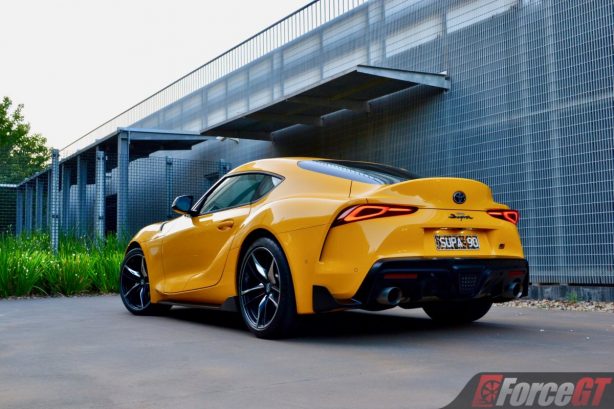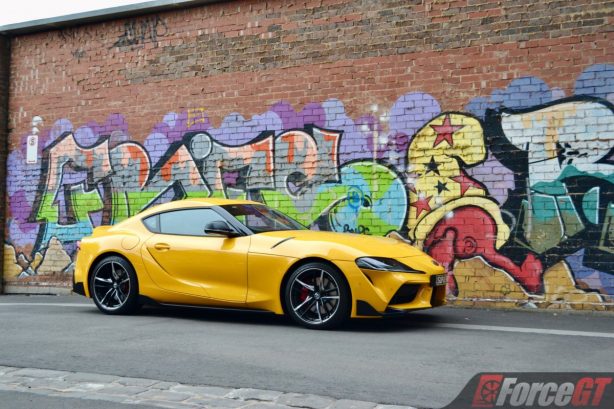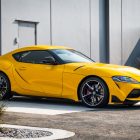I grew up with cars in the 90’s, an era widely regarded as the golden era of fun cars. Think BMW E36 M3, Ford Sierra RS Cosworth, Alfa Romeo GTV, Dodge Viper, Mitsubishi Lancer Evo… the list is endless. That era was particularly interesting in Japan, for it’s the decade where we saw an explosion of Japanese go-fast machines: Nissan Skyline GT-R R33 and R34, Mitsubishi GTO, Subaru WRX STI 22B, Mazda RX-7 FD, Honda NSX and Toyota MK4 Supra, just to name a few.
Fast forward to 2020 and sadly, more than half of those cars have been discontinued. With ever stricter emission control and the constant push for more environmentally cars, it’s getting increasingly difficult for a sports car proposal to pass the top brass of a car company. After all, the sports car is a niche product that is very costly to develop. Unless there is a short cut…
Well, there is, and Toyota has shown us how. Collaborating with BMW, Toyota has managed to resurrect the iconic Supra without putting a big dent in its financial report. The joint venture between the two automotive giants started in late 2013 and it produced the A90 GR Supra for Toyota and the Z4 for BMW. But Toyota was more of a financial partner in the collaboration which means the Supra was spawned from the Z4, rather than developed in tandem with it.
To Supra purists, there’s bad news up front. The new GR Supra is made in Austria (in the same factory that makes the Z4) rather than Japan, and the guts of it – from the engine to the transmission – are essentially the same as those found in the Z4. Don’t believe? Pop the driver’s door and you’ll find a sticker in the B pillar that says ‘Built by BMW AG’.
I know, it’s hard to digest. Being a big fan of the previous-generation A80 Supra myself, me too think ‘this isn’t a Supra, it’s a BMW!’ But trust me, you’ll get over it pretty quickly. Just ignore the Supra bit in its name and think of it as a completely new sports car from Toyota, and things start to get very positive.
First thing first, the looks. It started with the Toyota FT-1 concept from 2014 and that concept was meant to inspire the production Supra. The FT-1 design was such a hit but much of it was toned down in the production car, as expected. At least that’s the impression I got when the first official photos of the Supra surfaced. Well, photos don’t do justice because the Supra looks absolutely amazing in the metal.
The designers had set out to design a sports car and the Supra looks every bit like it. The long bonnet, low roof and wide haunches set the basis for the design and from there finer details were added such as the scoops and slats, ducktail spoiler and the Zagato-like double-bubble effect on the roof. The big wheel arches are filled with striking 19-inch wheels with polished spokes.
The Supra styling gives away none of its Z4 connection and is entirely fresh, entirely Toyota. In the bright yellow paintwork of my test car, the Supra never failed to turn heads everywhere it went during my week-long test. And when parked, countless smartphone photos were taken of it. Such was its visual impact that nearly every time I refuel the car at the petrol station, people would strike up a conversation with me about how good it looked.
Perhaps the only complain I have about the design is the extensive array of non-functional scoops and vents in the bumpers, above the front wheel arches and in the doors, some of which seem even counter-aerodynamic.
A friend of mine was kind enough to supply his own A80 Supra for some group shots with the new car and it’s interesting to still see some resemblances between the two. Despite the BMW influence, Toyota has kept some Supra roots in the styling and that’s a good thing.
It’s a completely different story on the inside, though, as everywhere you look spells BMW. The buttons, knobs and switchgear are all lifted straight from the Z4, so are the iDrive system, head-up display, climate controls and door handles. A slightly different graphical design has been applied to the infotainment screen and digital instrumentation display but still there’s no hiding its BMW base. In fact the displays look rather dull, like a cheapened out version of the BMW system.
Don’t get me wrong, the BMW system and controls are fantastic but I’d have hoped the Supra interior to have a little more differentiation, a bit more techno-Japanese and a bit less business-like.
Ignoring those, the driving position is great. You sit low and tight and the sports seats wrap around your back like they should in a sports car. Forward visibility is good but over the shoulder and rear view is horrible. You’ll need to heavily rely on the sensors and camera to reverse in tight spaces.
Unlike its predecessors, the new GR Supra is a strict two-seater and there isn’t much room behind the seats for storage. Further aback there’s a 290-litre boot which is good enough for a couple of shopping bags or small suitcases.
Now, on to the stuff that matters – the drivetrain. There’s a reason why Toyota had chosen BMW as the development partner of the new Supra. A straight-six is a must have for a Supra and BMW is the only major manufacturer that still makes one today. The BMW B58 powerplant is a 3.0-litre in-line six engine that is used not just in the latest Z4 but also in the 3 Series, 5 Series and 8 Series, as well as their respective SUV derivatives.
Paired with a single twin-scroll turbocharger and designed mainly for rear-wheel drive applications, the B58 naturally appealed to Toyota as a suitable modern-day Supra engine (though previous generations of Supra had twin turbos). In the Supra, the B58 makes 250kW of power and 500Nm of torque, some 35kW less than the same engine found in the Z4 M40i. Why is there a power deficit, I’m not too sure but I guess it’s something to do with keeping the best to yourself. Nevertheless, an aftermarket ECU mod should easily liberate those extra kilowatts, plus more.
Channeling power to the rear wheels is an eight-speed automatic that is also shared with the Z4. The ZF unit is the only transmission option available. Yep, there’s no manual on offer this time, at least not until BMW decides to have one for the Z4 M40i.
Certain oversea markets get a (also BMW-engined) 2.0-litre turbocharged Supra but this version is unlikely to make it to Australia any time soon, perhaps for fear of cannibalising the sales of Toyota’s other sports coupe, the 86.
So, how does it drive? Very good indeed, if you get the Supra name out of your head. The in-line six packs enormous mid-range punch thanks to the peak torque arriving early at just 1600rpm and hanging around until 4500rpm. There’s very little lag getting off the line and once on the go there’s an almost endless surge of pull right across the rev range. With just 1495kg of mass to haul, zero to 100km/h is over in a blistering 4.3 seconds (claimed), with 200km/h coming in at just over 16 seconds. Top speed is electronically limited to 250km/h.
Its straight line punch is given, but the way it’s delivered is like any other M Performance BMW – smooth, fast and not much else. Granted, it’s not unexpected and there’s nothing wrong with high output BMW in-line sixes, but as a Supra it ought to feel a bit more special, a bit more unleashed. The S55 twin-turbo in-line six from the M2 Competition would give the Supra some much needed attitude, plus a power hike to a mouth-watering 302kW and 550Nm. Again, there’s nothing the aftermarket world can’t fix.
The eight-speed auto delivers crisp and quick shifts but is no match to a dual clutch box in terms of engagement and connectedness. It also feels like having a tad too many gears when put through sporty driving – seven ratios would be ideal.
Despite sharing the same underpinnings, both Toyota and BMW have gone separate ways in tuning them. So it’s a case of BMW parts, Supra-specific flavour and feel. And on that front, Toyota has done a commendable job. The Supra’s handling is near faultless. There’s the BMW dynamics of balance, neutrality and lightfootedness that we have come to know and like, only here it’s infused with more playfulness and agility, the kind of attributes you get from a short wheelbase rear-wheel drive car. And it was Toyota who insisted on a short 2,470mm wheelbase, even shorter than that of the 86.
It’s easy to drive the Supra at the limit. You brake deep into a corner and then power out. The nose obeys your input and the rear plays along with your throttle. Wrapped in 255/35 and 275/35 Michelin Pilot Super Sports front and rear, the Supra offers tonnes of grip, which allows it to carry incredible speed in the bends.
The steering tune is also Toyota’s own and it’s perfectly weighted and nicely responsive, if not a little numb in feel just off center. The brakes are steel but offer immense stopping power, but for heavy track duty it’s still recommended to upgrade them for better resistant to fade.
As mentioned before, the noise is not entirely dramatic, but at least there’re exhaust pops and crackles on overrun to add to the aural experience. And if that’s not enough, being a Supra you’d bet there’d be a ton of aftermarket exhaust options.
Around town, the Supra’s suspension – MacPherson struts front, multi-link rear – doesn’t afford a lot of travel and can transmit nasty road bumps straight to the cabin. Make no mistake, it’s still a comfortable car overall, one that you can use as a daily, but long trips on badly surfaced B roads can have you feeling worn out quite quickly. On cruise, the engine is very refined and effortless, while NVH levels are kept at bay at all times.
And for those who care, fuel consumption is rated at a very respectable 7.7L/100km on the combined average, though with a heavy right foot I still managed a fairly responsible 9.7L/100km after nearly 800km of mixed real-world driving.
Verdict
Design & Comfort
Performance & Handling
Quality
Economy
Equipment & Features
OUR SCORE
4.1/5
+ Plus
- Great engine
- Strong performance
- Head-turning looks
- Well-judged ride/handling balance
– Minus
- Lacking character known to previous Supra’s
- No manual gearbox option
Overall
The new Toyota GR Supra may not feel like a true Supra but it’s certainly not short on pace and performance. In fact, it packs tremendous punch and serves up a heap of fun. It’s just lacking the kind of charisma and attitude that we have come to expect from a Toyota sports car bearing the Supra badge. But if you’re willing to take the Supra on face value and enjoy it, you’ll be entertained every time you get behind the wheel. Big time.
2020 Toyota GR Supra Pricing and Specification
| Pricing (Excluding on-road costs): | From $84,990 GT: $84,990 GTS: $94,990 (tested) |
| Warranty: | 5-year / unlimited km |
| Country of Origin: | Japan/Germany. Manufactured in Austria |
| Service Intervals: | 12 months/15,000km |
| Engine: | Turbocharged 3.0-litre in-line six-cylinder petrol: 250kW @ 6500rpm, 500Nm @ 1600-4500rpm |
| Transmission: | 8-speed automatic with paddle shifters |
| Drivetrain: | Rear-wheel drive |
| Power-to-weight Ratio (W/kg): | 170.9 |
| 0-100km/h (s): | Claimed: 4.3, Tested 4.4 |
| Combined Fuel Consumption (L/100km): | Claimed: 7.7; Tested: 9.7 |
| RON Rating: | 95 |
| Fuel Capacity (L): | 52 |
| Safety: | 7 airbags, ABS, BA, AEB, EBD, ESC, reverse camera, front and rear parking sensors, adaptive cruise control, blind spot monitoring, lane keep assist |
| Dimensions (L/W/H/W-B) mm: | 4,379/1,854/1,292/2,470 |
| Kerb Weight (kg): | 1,495 |
| Towing Capacity (kg): | N/A |
| Entertainment: | 8.8-inch touch screen, AM/FM/DAB+, Bluetooth, USB, AUX, Apple CarPlay / Android Auto, navigation |
Competitors:
BMW M2 Competition, Porsche Cayman, Alpine A110, Audi TTS, Ford Mustang, Nissan 370Z Nismo
 ForceGT.com Car News, Car Reviews, Video Reviews, Tuning and much more.
ForceGT.com Car News, Car Reviews, Video Reviews, Tuning and much more. 





































